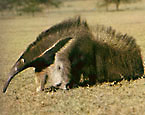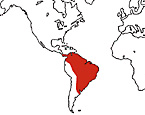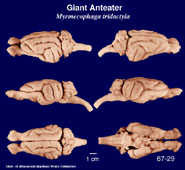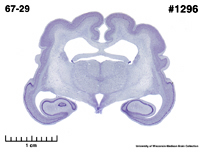|
Giant
Anteater
(Myrmecophaga tridactyla) #67-29 |
||||
|
|
Physical
characteristics and distribution
|
|
The Giant Anteater is the largest and best-known species of anteater. Anteaters lack teeth and feed mostly on ants and termites. The Giant Anteater has a tube-shaped head with a long, slender snout. Its coarse, brittle hair is mostly gray and forms a bushy mass on the tail and sides. A black band of hair bordered by white bands runs from the throat to the middle of the back. Some Giant anteaters grow over 6 feet (1.8 meters) in length, including a tail measuring about 3 feet (0.9 meters) in length. The Giant Anteater lives on the ground. It walks with its front feet turned on their sides to protect the claws. When feeding, the animal uses the large second and third claws of its front foot to rip open ant nests. It then flits its tongue, which is about 2 feet (60 centimeters) long, into the nest in rapid in-and-out movements to lick up the ants. A female Giant Anteater gives birth to one baby each year. The newborn rides on the mother's back for up to a year. It lives in tropical forests and grassy plains in Belize and Guatemala through South America to Uruguary and the Gran Chaco of Bolivia, Paraguay and Argentina. |
|
Description
of the brain
|
|
Animal
source and preparation
|
|
All specimens collected followed the same preparation and histological procedure.
|
Other
Related Resources (websites and publications)
List of Specimens | Explore Collections | Brain Sections | Brain Evolution | Brain Development | Brain Circuitry | Brain Functions | Location and Use | Related Web Sites | Contact Us | Search MSU Database | Personnel | Home



